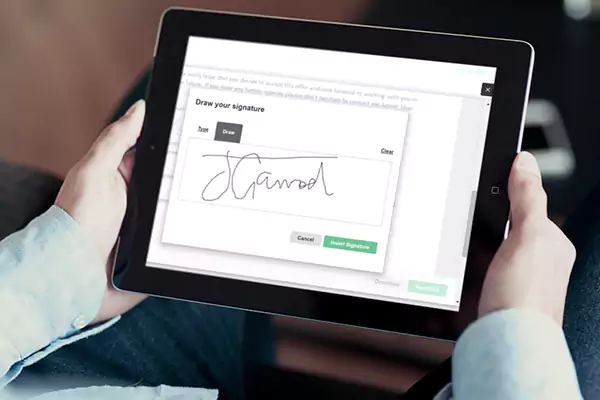The world is moving toward digital tools and automation to ease the workflow process for tedious and time-consuming tasks, specifically the ones that clasp manpower in repetitive tasks. Digital loans in banking streamline processes, benefiting stakeholders. Borrowers experience convenience, faster approval, and reduced paperwork. Lenders gain efficiency, lower costs, and improved risk assessment. Overall, this transition enables a more accessible and efficient loan ecosystem, benefiting borrowers, lenders, and the banking industry as a whole.

Despite loan origination cycles being automated, few banks still take the necessary to take physical signatures. This can be avoided by going for managed services platforms that offer eSignatures. Adopting electronic signature for loan applications makes business sense due to efficiency and cost savings. It eliminates the need for physical paperwork, reduces manual errors, and enables faster processing. This modern approach improves customer experience, enhances operational productivity, and simplifies the overall loan application process.
Several consumers who apply for a loan get tired of the lengthy process when they have to sign several times so that all the covenants can be in agreement. This beats the purpose of both the consumer who backs out of exhaustion or the bank that could not translate an applicant into a good-standing customer. However, eSignature platforms can change how banks handle their consumer’s applications while giving them a good onboarding experience.
Electronic Signatures
An eSignature, short for electronic signature, refers to a digital representation of an individual’s signature that is used to authenticate and validate electronic documents and transactions. It serves as a legally binding and secure way to sign documents in digital format, eliminating the need for physical signatures.
In the lending industry, banks can greatly benefit from the use of eSignatures. Firstly, it allows for a streamlined and efficient loan application process by eliminating the need for physical paperwork. This not only saves time but also reduces costs associated with printing, scanning, and storing physical documents.
Secondly, eSignatures enhance customer convenience and accessibility. Borrowers can sign loan agreements and other related documents from anywhere, anytime, using their preferred devices. This eliminates the need for in-person visits to the bank and provides a more user-friendly experience.
Additionally, eSignatures enhance security and compliance. Advanced encryption techniques ensure the integrity of the signed documents and protect against fraud. Banks can also maintain a robust audit trail, tracking the entire signing process for legal and regulatory purposes.
Banks Will Benefit from eSignatures
Implementing eSignatures in lending processes can bring significant improvements to a bank’s business. Here are five ways in which a bank can leverage eSignatures and the potential percentage of business improvement:
Faster Loan Processing and Approval
eSignatures eliminate the need for physical paperwork and manual handling, resulting in faster loan processing times. This efficiency can significantly reduce the turnaround time for loan approvals. With streamlined document signing, banks can improve their processing speed by an estimated 30-40%. This means quicker loan disbursements, enhancing customer satisfaction and retention.
Reduced Operational Costs
Adopting eSignatures eliminates costs associated with printing, storing, and physically transporting documents. It also reduces manual data entry and document verification efforts. Overall, banks can expect to save around 20-30% in operational costs related to paper-based processes. These cost savings contribute to improved profitability and resource allocation.
Enhanced Customer Experience
Traditional loan application processes often involve lengthy paperwork and in-person visits to the bank. By implementing eSignatures, banks can offer customers a convenient, digital experience. This shift improves customer satisfaction and reduces friction in the loan application process. As a result, customer retention rates can increase by approximately 15-20%, boosting overall business growth.
Improved Compliance and Security
eSignatures provide robust authentication and encryption measures, ensuring document integrity and security. By implementing eSignature solutions, banks can enhance compliance with legal and regulatory requirements, reducing the risk of fraud and non-compliance. The improved security measures can lead to a reduction in compliance-related issues and associated costs by up to 25%.
Increased Loan Application Volume
The ease and convenience offered by eSignatures can attract a larger number of borrowers. As the loan application process becomes more streamlined and accessible, banks can expect an increase in loan application volume by approximately 10-15%. This increased volume translates into a broader customer base and additional business opportunities.
Effective Implementation is Key
Banks can adopt eSignatures by following these key points:
Legal Compliance
Before implementing eSignatures, banks must ensure compliance with relevant laws and regulations governing electronic signatures in their jurisdiction. This may involve understanding and adhering to acts, regulations, and guidelines specific to electronic signatures, such as the ESIGN Act in the United States or the eIDAS Regulation in the European Union. Compliance ensures the legality and enforceability of eSignatures in loan transactions.
Choose a Reliable eSignature Solution
Banks should select a reputable eSignature solution provider that offers robust security measures, authentication methods, encryption, and audit trail capabilities. It is crucial to evaluate potential providers based on factors like industry reputation, compliance with security standards, scalability, integration capabilities, and customer support to ensure a reliable and secure solution.
Establish Internal Policies and Procedures
Banks should develop clear policies and procedures governing the use of eSignatures. These guidelines should cover aspects such as authentication methods, consent processes, document retention, and audit trail management. Establishing standardized procedures ensures consistency and compliance across all eSignature transactions and provides clarity to bank staff.
Employee Training and Education
Banks must provide comprehensive training to employees on the proper use and benefits of eSignatures. Employees should be familiar with the eSignature platform, its features, and the steps involved in initiating and managing eSignature workflows. Training should also focus on addressing customer inquiries and concerns related to eSignatures.
Conclusion:
A signature is taken on paperwork to serve as a legal and binding confirmation of an individual’s agreement or consent. It is also a symbol of consent that the parties to the contract or an agreement hold with each other. In short, a signature represents trust. Likewise, banks need to recognize the importance of eSignature and use trusted platforms to maintain the data security of their stakeholders.
















